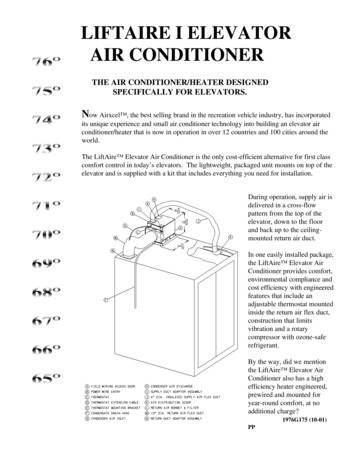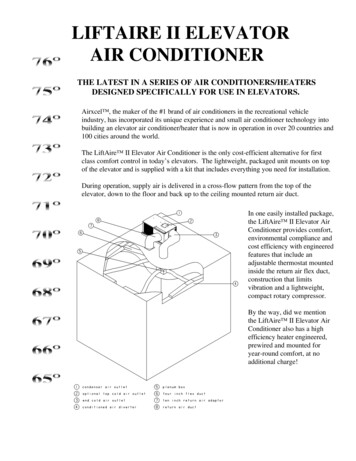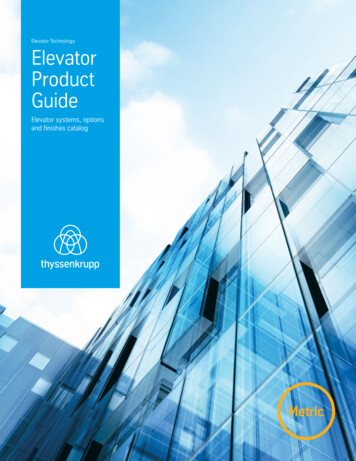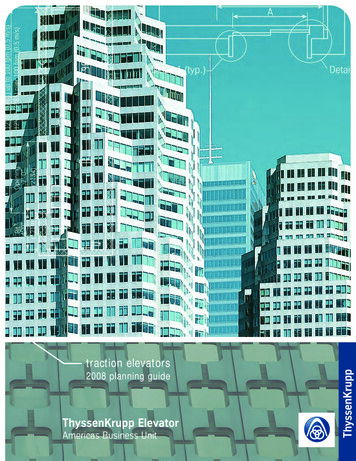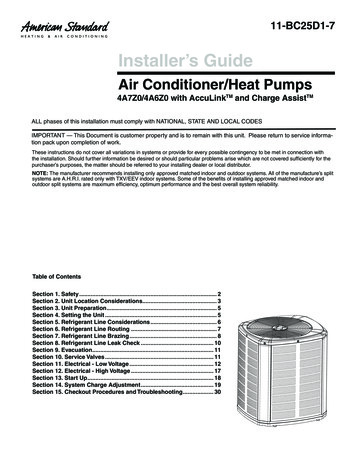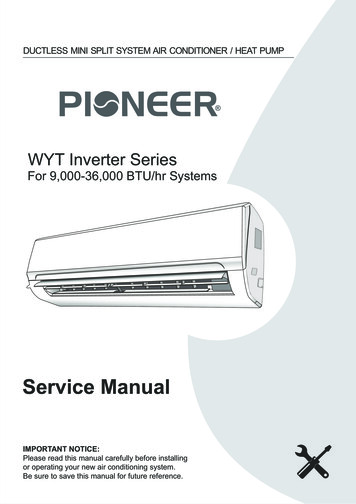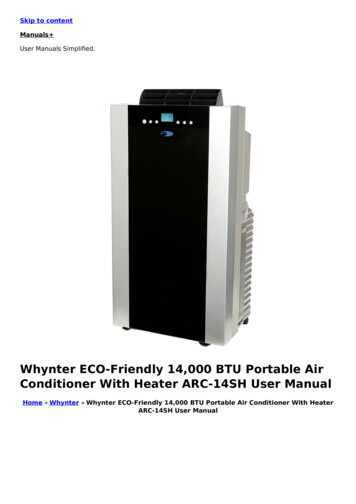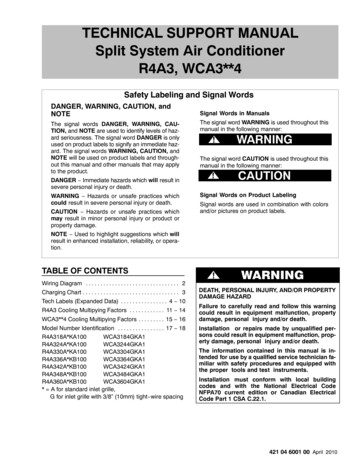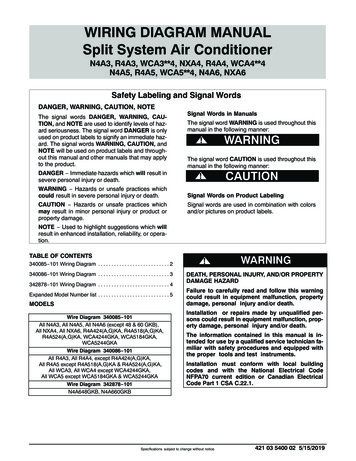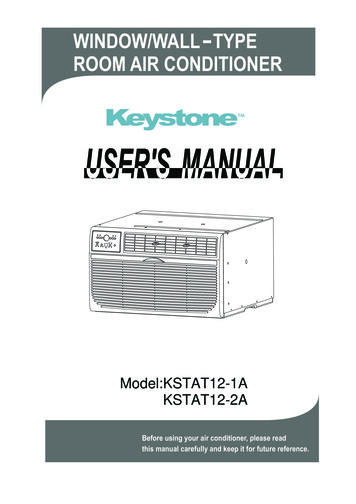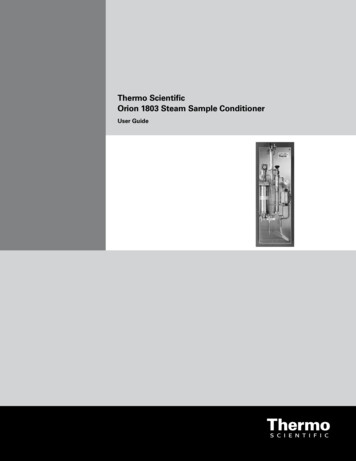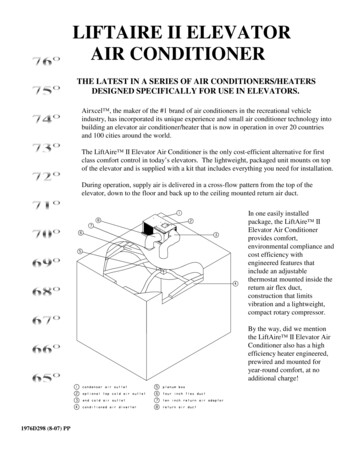
Transcription
LIFTAIRE II ELEVATORAIR CONDITIONERTHE LATEST IN A SERIES OF AIR CONDITIONERS/HEATERSDESIGNED SPECIFICALLY FOR USE IN ELEVATORS.Airxcel , the maker of the #1 brand of air conditioners in the recreational vehicleindustry, has incorporated its unique experience and small air conditioner technology intobuilding an elevator air conditioner/heater that is now in operation in over 20 countriesand 100 cities around the world.The LiftAire II Elevator Air Conditioner is the only cost-efficient alternative for firstclass comfort control in today’s elevators. The lightweight, packaged unit mounts on topof the elevator and is supplied with a kit that includes everything you need for installation.During operation, supply air is delivered in a cross-flow pattern from the top of theelevator, down to the floor and back up to the ceiling mounted return air duct.In one easily installedpackage, the LiftAire IIElevator Air Conditionerprovides comfort,environmental compliance andcost efficiency withengineered features thatinclude an adjustablethermostat mounted inside thereturn air flex duct,construction that limitsvibration and a lightweight,compact rotary compressor.By the way, did we mentionthe LiftAire II Elevator AirConditioner also has a highefficiency heater engineered,prewired and mounted foryear-round comfort, at noadditional charge!1976D298 (8-07) PP
SERVICE INFORMATIONWe believe that you will be pleased with the performance of the RVP LiftAire Elevator Air Conditioner.This unique product was specifically designed for installation on elevators. Should you need assistance in theinstallation of the product, or should you need service assistance after the unit is installed, please contact ourexclusive sales and service agent for this product line listed below:For Installations In North America:Elevator Motors Corporation80 Carolyn Blvd.Farmingdale, NY 11735-1525631-293-4220 (Voice)631-293-2714 (Fax)info@elevatormotors.com (E-Mail)Attention: Mark or Robert LaneFor Installations Outside North America:Global Elevator Products, Inc.P.O. Box 147Plainview, NY 11803-0147516-932-7968 (Voice)516-932-0987 (Fax)info@globalelevator.com (E-Mail)2
1. WARNINGSIMPORTANT NOTICEWARNING - SHOCK HAZARDThese instructions are for qualified individuals speciallytrained and experienced in installation of this type ofelectrical equipment and related system components.To prevent the possibility of severe personal injury orequipment damage due to electrical shock, always be surethe electrical power source to the appliance is disconnectedduring installation and service.Installation and service personnel are required by somestates to be licensed. PERSONS NOT QUALIFIEDSHALL NOT INSTALL NOR SERVICE THISEQUIPMENT.CAREFULLY FOLLOW ALL INSTRUCTIONS ANDWARNINGS IN THIS BOOKLET TO AVOID DAMAGETO THE EQUIPMENT, PERSONAL INJURY OR FIRE.NOTEWARNINGThe words “Shall” or “Must” indicate a requirementwhich is essential to satisfactory and safe productperformance and installation.Improper installation may damage equipment, can create ahazard and voids the warranty.The use of components not tested in combination with thisunit will void the warranty, may make the equipment inviolation of state codes, may create a hazard and may ruinthe equipment.The words “Should” or “May” indicate a recommendationor advice which is not essential and not required but isuseful or helpful.2. COMPONENT MATCH-UP1.6533-892 (115 V, 60 Hz) or 6573-892(240 V, 50 Hz) Package Air Conditioner2.6533-625 Installation Kit (Included)3. SPECIFICATIONS AND UNIT IDENTIFICATIONSPECIFICATIONSMODEL NO. 6533-892MODEL NO. 6573-892150 PSIG330 PSIG150 PSIG305 PSIGVolts115240Hz6050Phase11Maximum Overcurrent Protective Device20 Amps*15 Amps*Minimum Circuit Ampacity20 Amps*15 Amps*Heater Amps13.310.8BTUH Heating Capacity56008800BTUH Cooling Capacity14,00014,000Fan Motor HP - Amps1/5 - 2.11/5 - 1.0Blower Motor HP - Amps1/5 - 2.41/5 - 1.2Compressor RLA - LRA11.3 - 675.5 - 32R-22 Charge Weight24.0 oz.20.5 oz.Maximum External Static Pressure.80 IN H20.60 IN H20Maximum Outlet Air Temperature161 F. (71.7 C.)178 F. (81.1 C.)0 in.0 in.Design Pressures - Low SideHigh SideMinimum Spacing To Combustible Surface* Air conditioner only. Does not include condensate evaporator.3
4. UNIT DEPICTION FIGURESFIGURE 1FIGURE 2FIGURE 34
5. GENERAL INFORMATIONThe 6533 (115 volt) and 6573 (240 volt) series package airconditioners are intended for installation on the roof ofelevator cabs or like-sized indoor use contrivances.Installation area should be sufficient to allow proper cutoutsand unit mounting without cutting vital frame members orelectrical wiring. Structural members should not createrestrictions to airway ducts.Conditioned air is delivered from the air conditioner to theinterior of the enclosure through ducting that is supplied inInstallation Kit #6533-625 as shown in Figure 2.The system’s return air duct, thermostat, etc. are also found inthe Installation Kit.The air conditioner is powered by a 115 volt, 60 Hz, 1 Phase,20 Amp electrical service for the 6533 series and 240 volt, 50Hz, 1 Phase, 15 Amp electrical service for the 6573 series.Recommended installations are shown in Figures 3 & 4.Actual mounting and placement can vary according to existingconditions.6. UNIT INSTALLATIONRefer to Figure 3:1.cable. Attach thermostat with mounting bracket to a10-inch collar assembly using two (2) sheet metalscrews.The air conditioner draws in topside air to cool thecondensing coil. The air is drawn in from the end ofthe air conditioner (across the condensing coil), anddischarged out through the discharge opening.6.Cut a 10 1/8" square opening in the cab top as far aspossible from the intended location of the supply airdistribution scoops. Position 10-inch diameter collarassembly with the thermostat/bracket over theopening. Fasten the collar to the canopy with rivetsor screws. Using quality duct tape, seal the seamsaround the perimeter of the collar assembly.7.Install the four (4) supply air distribution scoops in anarea as far as possible from the return air 10-inchdiameter collar assembly installed in Step 6. Airfrom the scoops should have a clear path into theconditioned cab. Attach the scoop with adhesive,straps, brackets or by fastening through the part. Ifattaching with fasteners, pre-drill any clearance holesin the scoops to prevent cracking during installation.It is also good practice to mount the scoop away fromany heat producing devices such as lights, fixtures,etc.8.Attach one (1) 10-inch starting collar by crimping theexisting tabs and attach four (4) 4-inch starting collarsto the plenum box. Mount the plenum box below thecab top and run the 4 inch plenum supply air flex ductfrom the plenum to the four (4) air distributionscoops. Ensure that the most direct and shortestlength of duct is used. Cut off any excess. Secureduct at plenum and scoops using the duct tiesprovided. Cut a 14-inch diameter hole in the cab topfor the 10-inch diameter insulated supply air flex ductto pass through. Connect duct to the top of plenumand to the collar assembly installed in Step 2. Ensurethat the most direct and shortest length of duct isused. Cut off any excess. Secure the duct at theplenum and collar assembly using the duct tiesprovided.To provide adequate condensing airflow, the installermust adhere to the following guidelines:2. The air path to the condensing coil should beas direct and non-restrictive as possible. Do not block or restrict the dischargeopening. Ensure that there are no structural membersor panels which would serve to causecondenser discharge air to recirculate intothe condenser return air.Remove and discard the plate and styrofoam adapterfrom the desired supply air outlet (top or end).Attach the 10-inch diameter collar assembly using theexisting screws supplied on top of the air conditioner.3.Mount the 10-inch diameter starting collar to thereturn air inlet by crimping the existing tabs.4.Mount the air conditioner using the four shippingbrackets or use band or brackets of your own. Ifusing a condensate evaporator with the airconditioner, elevate the air conditioner 4-5 inches toensure proper drainage of condensate from the airconditioner drain pan to the evaporator.5.Mount the thermostat to the thermostat mountingbracket using the screws provided with thethermostat. Connect extension cable to thermostats5
9.10.Connect the 10-inch diameter uninsulated return airflex duct to the return air starting collar installed inStep 3. Secure the duct to the collar assembly usingthe duct ties provided.Determine the most direct and shortest length of ductto be used to connect the 10-inch diameteruninsulated return air flex duct to the 10 inchdiameter collar installed in Step 6. Cut a small slitthrough the 10-inch diameter uninsulated return airflex duct directly above the 10-inch diameter collarassembly and route the thermostat extension cablethrough the slit in the duct. Cut off any excess ductand attach duct to collar using the duct ties provided.Seal the duct where the thermostat cable exits with aquality duct tape.11.Plug remaining end of cable to the air conditionersthermostat 4-pin connector.12.Attach the 7/8 inch ID condensate drain hose to thedrain pan on the air conditioner and secure with thehose clamp provided.DANGER - SHOCK HAZARDDo not drill any openings into this air conditioner. Whenattaching any collars, ducts or adapters directly to the airconditioner, use only the pilot holes already provided.Drilling new openings and inserting screws may damageeither the refrigeration circuit or electrical wiring, causingpossible equipment damage, personal injury or death.7. ALTERNATE UNIT INSTALLATIONRefer to Figure 4:1.2.The air conditioner draws topside air to cool thecondensing coil. The air is drawn in from the end ofthe air conditioner, across the condensing coil, anddischarged through the discharge opening. Toprovide adequate condensing airflow, the installermust adhere to the following guidelines: The air path to the condensing coil should beas direct and non-restrictive as possible. Do not block or restrict the dischargeopening. Ensure that there are no panels or structuralmembers that cause the condenser dischargeair to be recirculated into the condenserreturn air.Remove and discard the plate and styrofoam adapterfrom the desired supply air outlet (top or end).Attach the 10-inch diameter collar assembly using theexisting screws supplied on top of the air conditioner.3.Mount the 10-inch diameter starting collar to thereturn air inlet by crimping the existing tabs.4.Mount the air conditioner using the four (4) shippingbrackets or use band or brackets of your own. Ifusing a condensate evaporator with the airconditioner, elevate the air conditioner 4-5 inches toensure proper drainage of condensate from the airconditioner drain pan to the evaporator.5.10-inch collar assembly using two (2) sheet metalscrews.Mount the thermostat to the thermostat mountingbracket using the screws provided with thethermostat. Connect extension cable to thermostatcable. Attach thermostat with mounting bracket to a66.Cut a 10 1/8 inch square opening in the cab top as faras possible from the intended location of the supplyair flex duct into the cab. Position 10-inch diametercollar assembly with the thermostat/bracket over theopening. Fasten the collar to the cab top with rivetsor screws. Using quality duct tape, seal the seamsaround the perimeter of the collar assembly.7.Install one (1) supply air distribution diffuser in thecab in an area as far as possible from the return air10-inch diameter collar assembly installed in Step 6.Air from the diffuser should have a clear path into theconditioned cab. The diffuser used is to beprovided by the installer and should be capable ofusing the 10-inch diameter insulated supply air flexduct. It is also good practice to mount the diffuseraway from any heat producing devices such as lights,fixtures, etc.8.Cut a 14-inch diameter hole in the cab top for the10-inch diameter insulated supply air flex duct to passthrough. Connect duct to top of diffuser and to thecollar assembly installed in Step 2. Ensure that themost direct and shortest length of duct is used. Cutoff any excess. Secure the duct at the diffuser andcollar assembly using the duct ties provided.9.Connect the 10-inch diameter uninsulated return airflex duct to the return air starting collar installed inStep 3. Secure the duct to the collar assembly usingthe duct ties provided.10.Determine the most direct and shortest length of ductto be used to connect the 10-inch diameteruninsulated return air flex duct to the 10-inchdiameter collar assembly installed in Step 6. Cut a
small slit through the 10-inch diameter uninsulatedreturn air flex duct directly above the 10-inchdiameter collar assembly and route thethermostat extension cable through the slitin the duct. Cut off any excess duct andattach the duct to the collar using the ductties provided. Seal the duct where thethermostat cable exits with a quality ducttape.11.Plug the remaining end of the cable into the airconditioners thermostat 4-pin connector.12.Attach the 7/8 inch ID condensate drain hose to thedrain pan on the air conditioner and secure with hoseclamp provided.1.2.3.4.5.Optional Supply Air (Top) OutletSupply Air (End) Outlet With 10" Dia. Insulated Supply Air Flex DuctSupply Air Distribution Diffuser By Installer10" Dia. Uninsulated Return Air Flex Duct Connected To 10" Dia. AssembliesThermostat With Mounting BracketFIGURE 48. INSTALLATION NOTESThe LiftAire Series of air conditioners are specificallydesigned and constructed for use on new elevator installations,modernizations and retrofits of existing elevator cabs. Theyare provided with all the materials needed to properly cooland/or heat an elevator cab. To ensure maximum efficiencyand operation, the following guidelines should be adhered to:1.type of operation you require. When thermostat isinstalled in the cab, it must be able to sense cabtemperature to operate properly. If placed within thefixture area of the cab, there must be a perforatedcover to allow cab air access to the thermostat.Locating the thermostat anywhere else affects theproper operation of the LiftAire unit and cooling ofthe elevator cab as designed.Supply and return registers in the cab should notrestrict airflow into and out of the cab. Anyresistance of the airflow will limit the effectiveness ofthe unit and create wind noise. The return air andsupply air registers should be as far away from oneanother as possible to ensure proper air circulation inthe cab and back to the air conditioner.2.While the installation kit provides a sufficient amountof supply and return air flexible duct, in order to limitairflow resistance, all duct connections should bethe most direct and the shortest possible. Cut anyextra flexible duct not required, connect flexible ductper previous installation instructions and discard anyextra material.3.Ensure that the thermostat is installed in thereturn duct or the cab. If using the standardthermostat, check that the temperature and operationsettings are correct. If using the automaticthermostat, make sure the unit is programmed for the4.7If you are retrofitting an existing cab, it may not benecessary to use the fan supplied in the originalcab. The LiftAire air conditioner has a fan that willrun continuously with proper settings of thethermostat. If you allow the cab fan to operate duringnormal conditions you will bring hot, cold or humidhoistway air into the cab, thereby defeating thepurpose of the air conditioner and its effectiveness.If it is permitted, remove the original fan to preventwarm hoistway air from entering the cab duringascent and descent of the elevator. If necessary, youcan use he original fan’s opening for the return airregister, provided it has 79 square inches of open areaand is far enough away from the supply air register toensure proper recirculation of the cool air. If usingthe LiftAire on a new installation, a cab fan isprobably not required. If a fan is required or in caseof power outage, it is recommended that the fanoperate only during power loss. In addition, the fan
should utilize a spring loaded or powered louver thanopens during fan operation. This preventsunregulated hoistway air from entering the cab duringair conditioner operation.5.All supply and return registers with duct work into thecab must be manufactured and installed to preventany air leaks and losses of the cold supply air fromthe air conditioner and return air back to the airconditioner.6.Never install the condensate evaporator under thereturn or supply air ducts. This can cause wateraccumulation, damage to the ducts and damage to thecab.7.It is the responsibility of the installer to ensure thatthe installation meets any and all building, electricaland other applicable codes.DANGER - SHOCK HAZARDDo not drill any openings into this air conditioner. Whenattaching any collars, ducts or adapters directly to the airconditioner, use only the pilot holes provided. Drilling newopenings or inserting screws may damage either therefrigeration circuit or electrical wiring, causing possibleequipment damage, personal injury or death.9. MAINTENANCE INSTRUCTIONSThe LiftAire Series of air conditioners require very littlemaintenance during normal operating conditions. Thefollowing are general requirements that should be performedevery 4-6 months.1.2.Air filters should be inspected and washed on aregular basis. Clogged filters will produce a loss ofair volume and possibly damage equipment. Do notoperate the unit without a return air filter. The filtersare reusable after being washed.3.Inspect and clean the condensate drain pan. Ensurethat the drain hole and hose are clear of debris toallow any condensate to properly drain.4.If a condensate evaporator is used, inspect to ensurethere is no debris on the guard or in the evaporatorpan. Ensure drain hole and hose are clear of debris.5.If an automatic thermostat is used, check the LCDdisplay and observe if the word “BATTERY” isflashing. If it is displayed, the “AA” alkalinebatteries are low and should be replaced. Seethermostat operating manual for battery replacementinstructions.Evaporator and condenser coils should be inspectedand, if dirty, cleaned on a regular basis. Remove byhand any paper or debris that might have collected onthe coils and blow compressed air through the coils.This should not have to be done very often unless theshaftway and installation are in a very dirtyenvironment.10. 115 (240) VOLT AC ELECTRICAL WIRINGWARNING - SHOCK HAZARD3.To prevent the possibility of severe personal injury orequipment damage due to electrical shock, always by surethe electrical power is disconnected or off before beginninginstallation.1.Power supply wire size should be determined percode and losses for long cable runs should be takeninto account to insure the proper voltage to the airconditioner at unit startup amperage.2.This air conditioner contains a compressorrefrigeration system and requires power from a 115(240) volt electrical circuit. The circuit connects toterminal lugs inside the unit.8High Voltage Routing Specifications - When routingthe high voltage supply wiring, the followingguidelines must be followed: High voltage wiring must be routed throughthe separate opening in the outer cabinet ofthe air conditioner. This opening is shownon Figure 1 as Field Wiring Line VoltageAccess. It is a 7/8 inch diameter opening for½ inch conduit. Do not allow excess wiring to contact theelectrical terminals or allow sharp screwends and edging that can damage the wireinsulation.
4.5.After connecting ground wire to groundinglug, verify the grounding wire cannot comeinto contact with any high voltage terminals.6.This unit is equipped with high and low pressureswitches to protect against fan failure and refrigerantloss. If either activates, the unit will lock out untilservice personnel inspect and repair any p
The LiftAire II Elevator Air Conditioner is the only cost-efficient alternative for first class comfort control in today’s elevators. The lightweight, packaged unit mounts on top of the elevator and is supplied with
